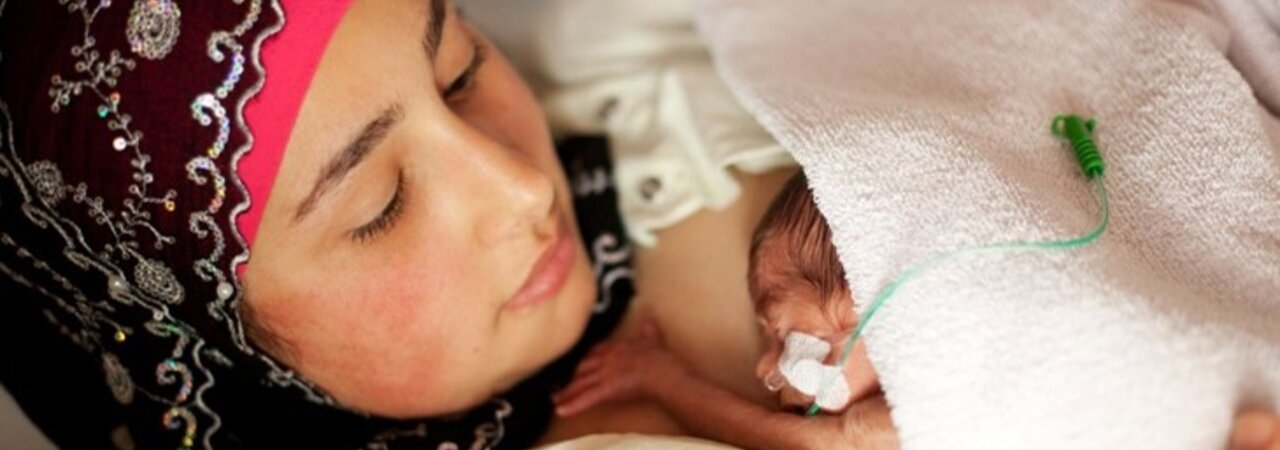You are currently viewing:
Medela - English
You can select an alternative Medela website in one of these countries:
- Products
- Articles
- Medela Family
- Services
- Lactation Professionals
Transition to at-breast feeding
Time to read: 4 min.
Skin-to-skin care is an intervention that empowers mothers to express and provide their milk to their infants and supports transition to breastfeeding by offering access and early opportunities for non-nutritive and nutritive sucking at the breast.

Skin-to-skin care (also known as kangaroo mother care - KMC) is a well-known practice of holding the naked infant vertically between the mother’s breasts and below her clothes.1
Skin-to-skin care is recommended for all infants globally.2
Skin-to-skin care, when possible, can be continuous 24h a day. Intermittent skin-to-skin care (alternating periods of time between a NICU incubator and a minimum of 1 hour with a parent) several times a day is recommended to give therapeutic benefits, and enables the infant to stabilise and regulate core physiological and behavioural functions following transfer.3
NICU infants can commence skin-to-skin care as soon as the infant is physiologically stable after birth; this applies to extremely low birthweight and ventilated infants.1,2,4
Skin-to-skin care supports a significant reduction in infant mortality and morbidity globally.3
Regular skin-to-skin care empowers mothers to
Regular skin-to-skin care supports the NICU infant to transition from enteral to oral feeding through
Collect data on frequency and duration of skin-to-skin care
Carry out a monthly audit of the data to measure:
• Percentage of infants receiving skin-to-skin care at least once per day.
• Daily frequency and duration of skin-to-skin care.
• Reasons for sub-optimal provision of skin-to-skin care.
Audit records monthly to review progress, identify challenges and implement interventions to improve skin-to-skin care practice and support lactation outcomes.
Downloads
1. Nyqvist KH et al. Towards universal Kangaroo Mother Care: recommendations and report from the First European conference and Seventh International Workshop on Kangaroo Mother Care. Acta Paediatr. 2010; 99(6):820–826.
2. World Health Organization (WHO). Kangaroo mother care to reduce morbidity and mortality in low-birth-weight infants. 2020.
3. Nyqvist KH et al. State of the art and recommendations. Kangaroo mother care: application in a high-tech environment. Acta Paediatr. 2010; 99(6):812–819.
4. Ludington-Hoe SM et al. Safe criteria and procedure for kangaroo care with intubated preterm infants. J Obstet Gynecol Neonatal Nurs. 2003; 32(5):579–588.
5. Acuña-Muga J et al. Volume of milk obtained in relation to location and circumstances of expression in mothers of very low birth weight infants. J Hum Lact. 2014; 30(1):41–46.
6. Nyqvist KH et al. Expansion of the baby-friendly hospital initiative ten steps to successful breastfeeding into neonatal intensive care: expert group recommendations. J Hum Lact. 2013; 29(3):300–309.
7. Baley J. Skin-to-skin care for term and preterm infants in the neonatal ICU. Pediatrics. 2015; 136(3):596–599.
8. Assad M et al. Decreased cost and improved feeding tolerance in VLBW infants fed an exclusive human milk diet. J Perinatol. 2016; 36(3):216–220.
9. Spatz DL. Ten steps for promoting and protecting breastfeeding for vulnerable infants. J Perinat Neonatal Nurs. 2004; 18(4):385–396.
10. Uvnäs-Moberg K. Neuroendocrinology of the mother-child interaction. Trends Endocrinol Metab. 1996; 7(4):126–131.
11. Prime DK. Dynamics of milk flow and milk ejection during breast expression in women [PhD Thesis]: The University of Western Australia; 2010.
12. Flacking R et al. Closeness and separation in neonatal intensive care. Acta Paediatr. 2012; 101(10):1032–1037.
Articles that may be of interest